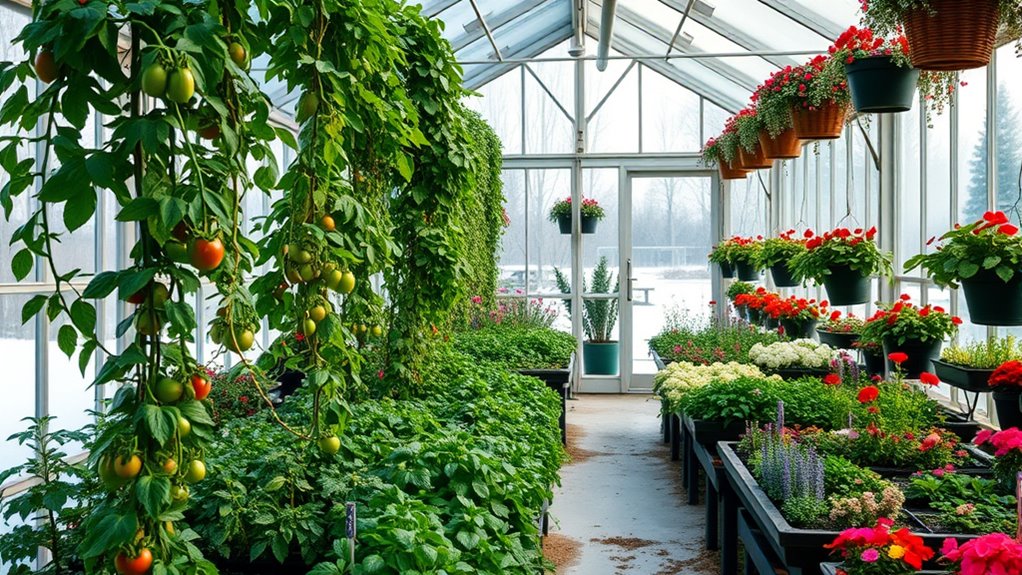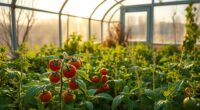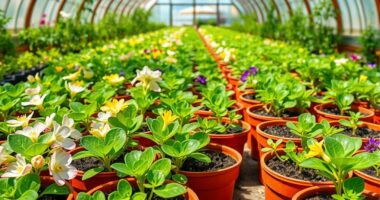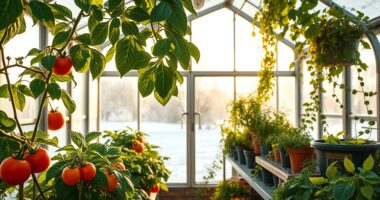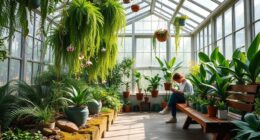To plan for year-round greenhouse gardening, focus on controlling your environment with efficient ventilation, heating, and cooling systems to maintain stable temperature and humidity. Choose adaptable crops suited to each season, and design your layout with space-saving features like vertical shelves. Use supplemental lighting and insulation to maximize plant growth during shorter days. Incorporate sustainable practices such as composting and renewable energy to boost longevity. Exploring these strategies further will help you maximize your greenhouse’s potential year-round.
Key Takeaways
- Implement climate control systems like heating, cooling, and ventilation to maintain optimal conditions throughout all seasons.
- Use season-specific crop selection and adjust fertilization to ensure year-round productivity.
- Incorporate insulation, shading, and supplemental lighting to adapt to seasonal light and temperature changes.
- Regularly monitor soil moisture, temperature, and humidity to make timely environmental adjustments.
- Plan efficient layout and airflow management to prevent pests, mold, and ensure easy maintenance year-round.
Understanding the Climate Control Systems for Your Greenhouse
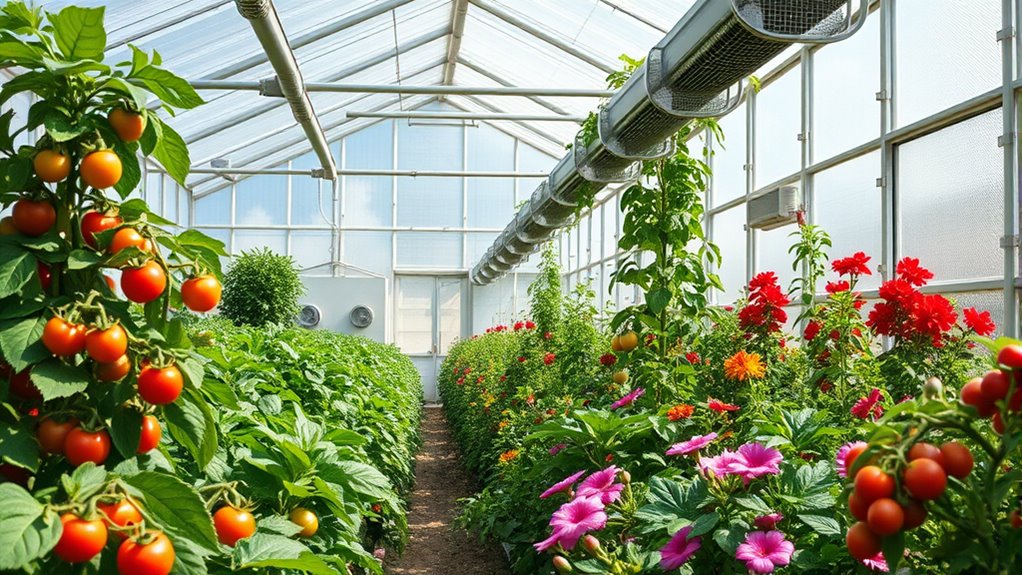
To create the ideal environment for your plants, understanding how climate control systems work is essential. Ventilation systems play a pivotal role by ensuring fresh air circulates, preventing stagnation and excess heat. Proper airflow helps regulate temperature and reduces the risk of disease. Additionally, integrating humidity regulation systems can help maintain optimal moisture levels, preventing issues like mold or plant dehydration. Automated systems can monitor humidity levels and adjust fans or misting devices accordingly. Incorporating affiliate partnerships can also provide access to quality climate control equipment and resources for your greenhouse. Leveraging remote work principles, such as remote monitoring and control, can further optimize your greenhouse management from anywhere.
Selecting the Right Crops for Year-Round Growth

Choosing the right crops is essential for maintaining a productive greenhouse throughout the year. Your crop selection should focus on plants that thrive under your specific climate conditions and grow well together, ensuring plant compatibility. Consider crops with similar temperature, humidity, and light needs to simplify management. Leafy greens like lettuce and spinach grow quickly and can be harvested multiple times, making them ideal for year-round cultivation. Tomatoes and peppers require more warmth but can be grown successfully if you maintain consistent conditions. Avoid pairing crops that compete for nutrients or have conflicting environmental needs. By selecting compatible plants, you optimize space, reduce pests, and improve yields, keeping your greenhouse productive regardless of the season. Additionally, understanding the refrigeration cycle can help in designing climate control systems that optimize energy efficiency and environmental conditions within your greenhouse. Incorporating knowledge of seasonal variations can further enhance your planning and ensure continuous crop production throughout the year. Recognizing crop rotation principles is also vital to maintaining soil health and preventing disease buildup in your greenhouse. Implementing integrated pest management strategies can further protect your crops and reduce reliance on chemical controls. Understanding plant growth cycles can assist in scheduling planting and harvesting to maximize productivity year-round.
Designing Your Greenhouse Layout for Optimal Productivity
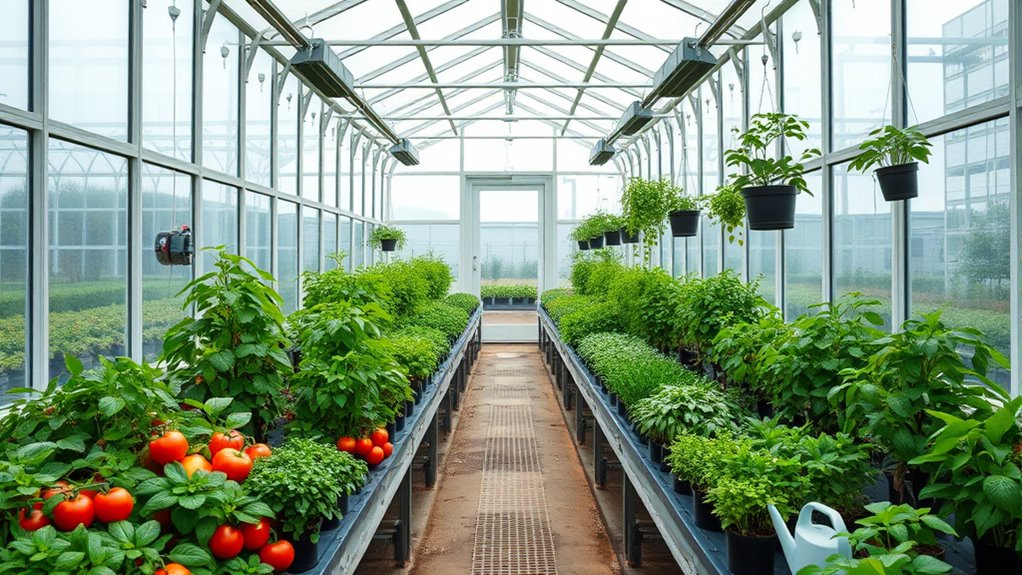
Designing your greenhouse layout thoughtfully can substantially boost productivity by maximizing space and ensuring efficient workflows. Start by planning your plant zones to minimize unnecessary movement and make sure high-demand crops are easily accessible. Incorporate effective ventilation strategies, such as adjustable vents and exhaust fans, to regulate airflow and prevent overheating. Proper ventilation enhances plant health and reduces disease risk, supporting year-round growth. Additionally, considering climate control systems can help maintain optimal conditions regardless of weather fluctuations. Use space optimization techniques like vertical shelving and movable benches to make the most of limited space. Guarantee pathways are wide enough for easy access and maintenance. Incorporating air circulation strategies further improves airflow and reduces the likelihood of fungal issues. A well-organized layout improves resource management, simplifies watering, and reduces clutter. Paying attention to ventilation strategies can significantly improve overall airflow and temperature regulation. By focusing on ventilation strategies and space optimization, you’ll create a functional environment that promotes healthy growth all year. Additionally, integrating ventilation control devices can fine-tune airflow and humidity levels for even better climate management. Regularly monitoring temperature and humidity levels ensures your greenhouse remains an ideal environment for your plants.
Managing Light and Temperature for Different Seasons

Effective management of light and temperature is essential for maintaining healthy plants throughout the year. During shorter winter days, supplement your greenhouse with supplemental lighting to guarantee your plants receive enough light for growth. Use grow lights that mimic natural sunlight, and adjust their timing based on the season. Incorporating safety features into your heating setup, such as thermostats or automatic shut-offs, can prevent overheating and ensure safe operation. Insulation techniques, such as double glazing or adding thermal curtains, help retain heat during cold months, reducing energy costs and maintaining stable temperatures. In warmer seasons, ventilate your greenhouse to prevent overheating, and use shading materials if necessary. Regularly checking your hosting and VPS services ensures smooth operation of any electronic systems supporting your climate control. Monitoring your climate control systems for optimal performance can also prevent malfunctions that might harm your plants. Consistently monitoring temperature and light levels allows you to make timely adjustments, creating an ideal environment regardless of external weather conditions. Proper management ensures your plants thrive year-round, no matter the season. Additionally, understanding the importance of system security helps protect digital infrastructure supporting your climate control from cyber threats. Maintaining a comprehensive plant care routine can further optimize growth and health throughout the year.
Watering Techniques and Humidity Control
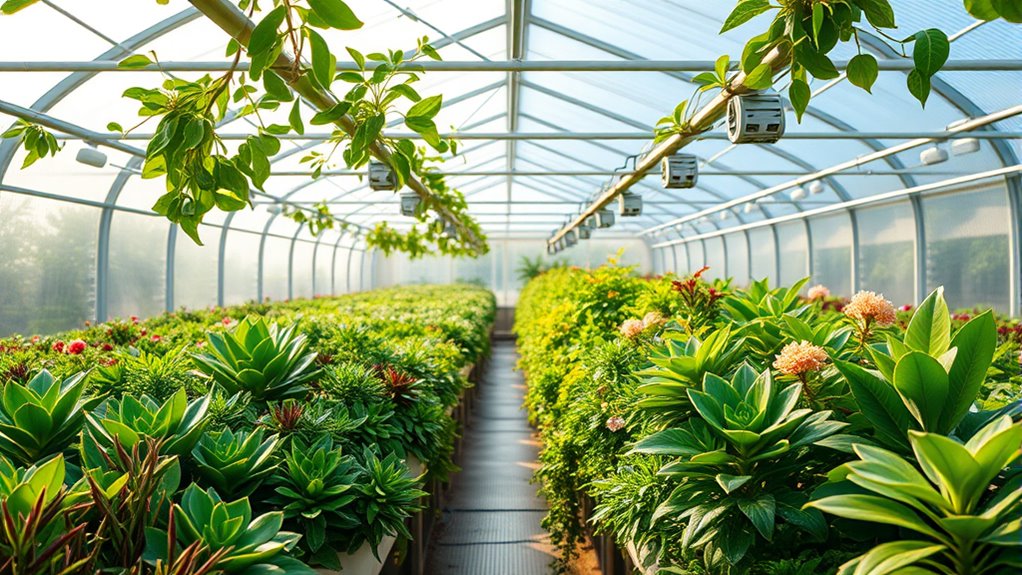
Maintaining proper watering techniques and humidity levels is essential for healthy greenhouse plants. Using drip irrigation ensures consistent, efficient watering that minimizes waste and prevents overwatering. Adjust your system to deliver water directly to plant roots, promoting healthy growth and reducing disease risk. Regularly monitoring humidity levels with appropriate gauges helps you fine-tune your environment more precisely. Filtration systems, such as HEPA filters, can also improve air quality by removing allergens and dust, supporting a cleaner, healthier greenhouse atmosphere. During dry or heated periods, increase humidity by misting or adding a humidifier, but avoid excessive moisture that could foster mold. Conversely, in overly humid environments, improve air circulation and reduce humidity to prevent fungal issues. Proper humidity control is vital for preventing plant stress and disease development. Regularly checking humidity and adjusting watering schedules keeps your plants thriving year-round. Staying attentive to these factors creates a balanced environment that supports healthy, vigorous growth.
Soil Preparation and Fertilization Strategies

To guarantee healthy plant growth, you need to start with proper soil testing to understand its nutrient levels.
Choosing the right organic fertilizers can boost your soil without chemical additives.
Adjusting nutrients seasonally helps your plants thrive year-round.
Soil Testing Methods
Have you ever wondered how to guarantee your greenhouse soil is just right for planting? The key is performing proper soil testing.
Start with soil testing to determine nutrient levels, pH, and texture. You can use a simple home test kit or send a sample to a lab for a detailed nutrient analysis.
Soil testing provides vital information about deficiencies or excesses, guiding your fertilization strategy. It helps you understand which nutrients need supplementation and if your soil’s pH needs adjustment.
Regular testing ensures your soil remains balanced throughout the year, preventing problems before they start.
Organic Fertilizer Options
Are you looking for natural ways to nourish your greenhouse plants? Organic fertilizers like compost tea and organic amendments are excellent choices. Compost tea provides quick nutrient uptake and boosts beneficial microbes, improving soil health. Organic amendments such as manure, bone meal, or kelp meal enrich the soil gradually, promoting healthy growth. Use a mix of these options to tailor fertilization to your plants’ needs.
| Organic Fertilizer | Benefits |
|---|---|
| Compost Tea | Rapid nutrient delivery, microbial boost |
| Bone Meal | Phosphorus source for root growth |
| Kelp Meal | Trace minerals and growth stimulants |
| Manure | Organic matter, nutrients release |
| Blood Meal | Nitrogen boost for leafy growth |
Seasonal Nutrient Adjustments
Adjusting your soil nutrients according to the seasons guarantees your greenhouse plants stay healthy and productive year-round. To do this effectively, focus on proper nutrient timing and tailored fertilization schedules for each season.
During active growth periods, increase nitrogen and potassium to support foliage and fruit development. In contrast, reduce fertilization in dormancy phases to prevent nutrient buildup.
Regular soil testing helps you monitor nutrient levels and adjust your fertilization plans accordingly. Implementing seasonal nutrient adjustments ensures your plants receive the right nutrients at the right times, promoting ideal growth and preventing deficiencies.
Pest and Disease Prevention Throughout the Year

Maintaining a pest- and disease-free greenhouse year-round requires consistent vigilance and proactive measures. You should regularly inspect plants for pest identification, catching issues early before they spread. Keep a close eye on common pests like aphids, whiteflies, and spider mites, and remove any infested leaves immediately.
Implement good sanitation by cleaning tools and removing dead plant material to reduce disease sources. Use proper watering techniques to avoid creating damp environments that promote disease development.
When you spot signs of disease, act quickly with targeted management strategies, such as organic fungicides or resistant plant varieties. Staying vigilant throughout the year ensures you catch problems early, making disease management more effective and helping you keep your greenhouse healthy and productive.
Incorporating Sustainable Practices for Longevity
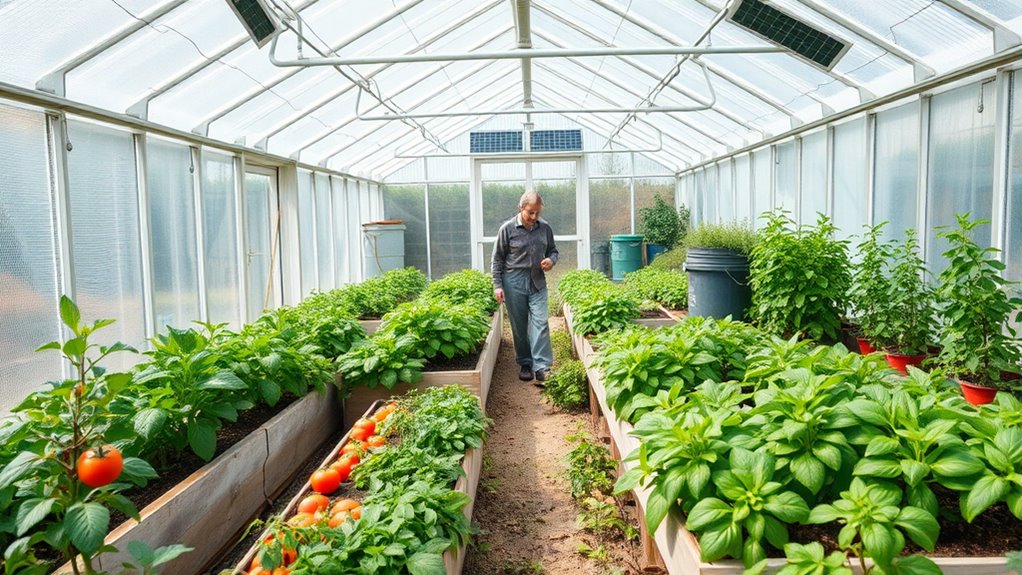
Incorporating sustainable practices into your greenhouse gardening not only helps safeguard the environment but also guarantees the longevity of your operation. Start by adopting effective composting methods to recycle organic waste, enriching your soil naturally and reducing reliance on chemical fertilizers. Using compost improves soil health and minimizes waste sent to landfills.
Additionally, consider integrating renewable energy sources like solar panels or wind turbines to power your greenhouse. These energy solutions lower your carbon footprint and decrease long-term operational costs.
Embracing these practices ensures your greenhouse remains productive and environmentally responsible over time. By continuously optimizing composting methods and harnessing renewable energy, you create a resilient, eco-friendly system that supports year-round gardening while contributing to sustainability.
Monitoring and Adjusting Your Greenhouse Environment
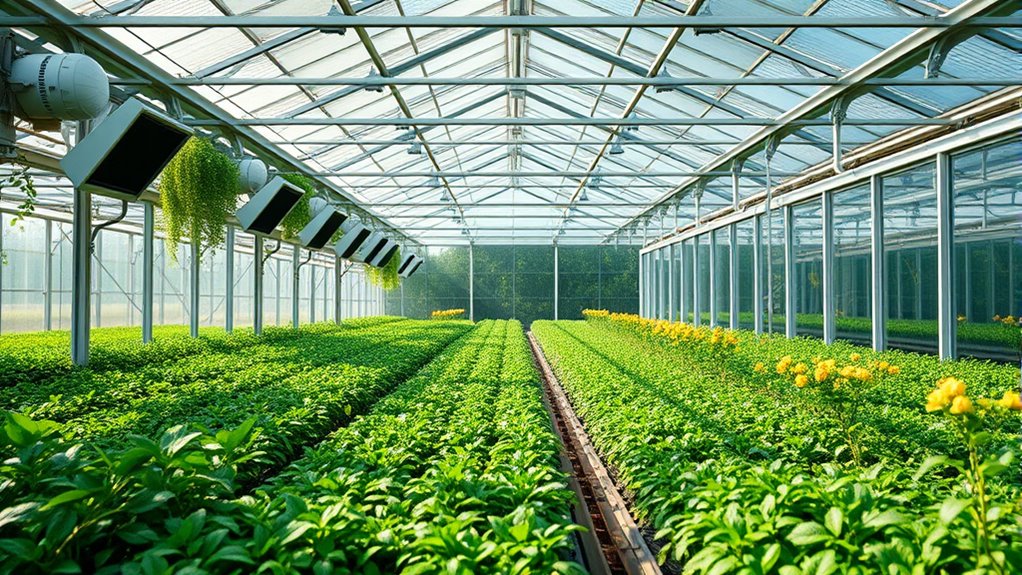
Monitoring your greenhouse environment is essential to guarantee ideal growing conditions. Regularly check soil moisture levels to assure your plants receive enough water without becoming waterlogged. Use a moisture meter or feel the soil to determine if watering is needed.
Proper airflow management keeps the air circulating, preventing mold and pests while maintaining consistent temperatures. Adjust vents, fans, or open windows to improve airflow, especially during hot or humid days.
Keep a close eye on temperature and humidity readings, making adjustments as necessary. These steps help create a stable environment, promoting healthy growth and maximizing yields.
Frequently Asked Questions
How Can I Optimize Energy Efficiency in Year-Round Greenhouse Gardening?
To enhance energy efficiency, you should focus on integrating solar heating and LED lighting into your greenhouse. Solar heating captures natural warmth, reducing your reliance on electric sources, especially during colder months.
Use energy-efficient LED lighting to supplement natural light, ensuring plants thrive without excess power consumption. Regularly monitor and adjust your systems to prevent waste, and insulate well to retain heat.
These steps help you save energy while maintaining ideal growing conditions year-round.
What Are the Best Ways to Extend the Growing Season Naturally?
Ever wonder how you can keep your garden thriving year-round? To naturally extend your growing season, focus on season extension techniques like using row covers, cold frames, and thermal mass.
Combine these with smart crop selection strategies—plant hardy varieties and succession crops. These methods protect your plants from extreme weather, allowing you to enjoy fresh produce longer, no matter the season. Isn’t that the ultimate gardening goal?
How Do I Prevent Temperature Fluctuations From Affecting Plant Health?
To prevent temperature fluctuations from harming your plants, focus on humidity regulation and thermal buffering. You can achieve this by installing a humidifier or dehumidifier to maintain consistent humidity levels, which helps stabilize temperature.
Use thermal mass like water barrels or stone to absorb heat during the day and release it at night. Proper insulation and ventilation also help balance temperature fluctuations, creating a stable environment for healthy plant growth.
What Are Cost-Effective Methods for Greenhouse Insulation?
While insulation might seem costly, you can keep expenses low by using thermal curtains and reflective mulching. Thermal curtains act as a barrier during cold nights, trapping heat inside.
Reflective mulching helps conserve warmth by reflecting radiant energy back to plants. These methods are affordable, easy to install, and effective, allowing you to maintain a stable environment without breaking the bank.
Plus, they’re reusable and eco-friendly, offering long-term savings.
How Can I Automate Climate Control for Minimal Manual Adjustments?
To automate climate control, you should install a smart system that manages your greenhouse environment. Use automated watering to keep plants hydrated and humidity regulation to prevent mold.
Connect sensors to control fans, heaters, and vents, ensuring ideal conditions without manual adjustments. This setup saves time, reduces energy use, and maintains steady temperatures, so your plants thrive year-round with minimal effort.
Conclusion
Think of your greenhouse as a living symphony, where each element plays a crucial role in harmony. By mastering climate control, selecting the right crops, and fine-tuning your environment through seasons, you create a melody of productivity year-round. Stay attentive, adapt to changes, and nurture your space with sustainable practices. With patience and care, your greenhouse will flourish like a well-tuned instrument, providing fresh bounty no matter what the calendar says.
